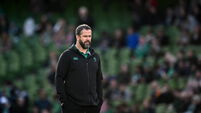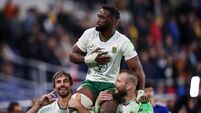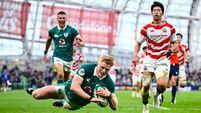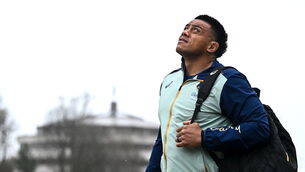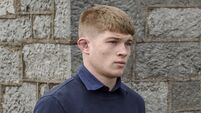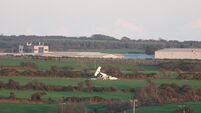Ronan O’Gara: How the 'phantom attacker' haunted James Lowe for decisive Welsh try

Ireland's James Lowe is tackled by Wales' Ken Owens (right) and Alun Wyn Jones during the Guinness Six Nations match at Principality Stadium, Cardiff. Going forward Lowe impressed for Ireland, however he was caught out in defence for Wales' crucial scores. Picture: David Davies
We can resort to ifs, buts, and maybes in relation to last weekend, but if we do that, maybe we are missing some key points.
Wayne Barnes is a genuinely excellent referee. He is the best out there on the rule book and rugby’s ever-changing laws, as perhaps a barrister should be. His penalty in Cardiff against Tadhg Beirne for being ‘in the tackle zone’ was a new one on me, and sounded like one of those makey-uppy things, but I am not going to challenge his authority.
I know if you put 10 coaches and players in a room, and they all knew their stuff, there would be half a dozen different interpretations of that particular scenario. You are into the definition of a ‘tackle’ and a ‘ruck’ — and you don’t want to go there if certainty is your thing. Barnes delivers great explainers on social media of the laws of the game, by the way, if you’re that way inclined. Go into YouTube and search ‘throw the book Wayne Barnes’. You’ll enjoy.
If my aunt had different genitalia, she’d be my uncle, and all that, so the notion that the three points from the penalty was the difference between Ireland losing or not is a stretch. If we are resorting to Messrs Maybe, If, and But, maybe Wales would have scored a try anyway from that advantageous position.
Unfortunately, we should be looking closer to home for the cause. The cases against Peter O’Mahony and Billy Burns have been well prosecuted in the court of public opinion. I am surprised there hasn’t been more discussion on Ireland’s defending for the two decisive Welsh tries.
It is undeniable that James Lowe was the central figure for the George North and Louis Rees-Zammit scores. The winger kicked beautifully and added a positive dimension to Ireland’s attack but his defensive decision-making in those instances need further scrutiny and explaining.
The first one, from George North at 13-6, is a straight-up case of looking for a phantom attacker (Halfpenny) who is so much less of a threat at that moment. There is only one live threat in that moment, it’s George North, you hit him stone dead, get him down on the ground. End of story. Why push off onto the ‘ghost’ outside? The threat is North. Hit the threat.

If his miscalculation for the Zammit-Rees try wasn’t worse, it was just as concerning. In layman’s terms, if you’re the second last defender, then you should be lining up the second last attacker. There was no threat inside, Ireland had numbers, but again Lowe shot up and in on North, forcing Hugo Keenan in one and facilitating a stroll in for Rees-Zammit, although kudos for a serious pair of wheels on Tadhg Furlong in his effort to get across.
Let’s be fair and apply context here. We are talking about fractions of seconds. If it was easy, everyone would be doing it. But scanning in front of you, watching where the ball is and numbering off is a critical part of Test defending. If it’s a five-on-three for the attack, of course Lowe would have had to do something spectacular.
But Ireland were lined well, it was five-v-five (in fact probably six v five in Ireland’s favour), hence you number off against the man opposite you. Lowe hit in a channel, which has essentially created a problem when there was no try on.

I am looking at it again here, and thinking ‘wow, what precisely did you see there, James?’ There’s a defensive line of Will Connors, Josh van der Flier, Furlong, Ringrose, Lowe, and Keenan. Ringrose is shooting up on George North, who is taking the ball stationary. Ringrose easily has North, but I’m taken by what Lowe’s scanning — and it isn’t Leigh Halfpenny, which is where his head should be at. North is the third Welsh attacker, Lowe is the fifth Irish defender.
Amazing what happens when the brain is fried and the heartbeat is racing. Why is he going near George North at all? If North was running hard, maybe you have to respect that, but Ringrose is comfortably going to get him, and showing no stress signs. It was high irony to see some chatting about Keith Earls errors on the day (probably his first less than average game in three seasons), when they were nothing and nowhere near the scale of Lowe’s.
Will they both start against France, and how quick is the remedy for Lowe’s defending? Alas, not that quick.
Why does this happen? James Lowe’s game has been shaped in Super Rugby, where attack is 80% of the game. How many of these scenarios in his Leinster club career has he seen?
Leinster are rarely if ever under PRO14 pressure with these set of pictures for James Lowe to compute, so maybe, if, but… But this is not a small ‘but’, it is a capital letters B.U.T. Proper defence is 50% of the game in the northern hemisphere. It’s not that long ago the Ireland debate on suspect defending was about Jacob Stockdale, who is 24 and still learning his trade.
James Lowe will be 29 this summer and will go to the next World Cup with Ireland because we need his attacking talent. His age profile is right and as Saturday proved, those 60m raking kicks off his left side gave Ireland a great attacking option, got their chase line higher up the pitch and reduced the reliance on the box kick. He is also deadly with ball in hand, which is ideal for southern hemisphere rugby where it’s you score-we score. Here he is trying to adjust to ball-watching defence and how fundamental that is in this part of the world. The trouble is that test level is not the ideal place to be schooled, as Sunday showed. He will need a forgiving coach with Ireland because Andy Farrell believes the pay-off — in terms of his value with ball in hand — is worth it.
Whether Lowe starts Sunday against France, I don’t know. The form line indicates a first French win in Dublin since 2011 when they triumphed 25-22.
They can get rattled when the crowd gets into them but that is no longer an edge Ireland enjoys. Where once it was a disadvantage in the Six Nations to play a feisty Italy first, now it’s a souped-up training run without the pressure of the result being in any doubt. They have had their ideal tune up.
So why do I believe it will be a home win? Galthie’s France are confident, ambitious, and mentally in a good place. Ireland will be scrapping, cranky, and will dispense with the niceties. They haven’t lost the opening two games in the Six Nations era and I don’t anticipate that changing. Ireland has almost patented this particular mindset.
There has been plenty said here and other places about Antoine Dupont, who is at the heart of everything for France. Who is at the heart of everything for Ireland at the moment? For me it’s Tadhg Beirne. Good management finds a way to work the best players into any team, irrespective of what number he is wearing. Ireland needs leaders and he has the look of one.
The indications are that Johnny Sexton will play against France. If he doesn’t, Ross Byrne could start but it’s important and a show of strong management to keep Billy Burns in the matchday group.
Simon Zebo did well again for Racing 92 against us last Sunday. La Rochelle were 10-0 down in less than 10 minutes and 23-5 behind midway through the second half. Clearly, we were giddy with excitement at getting to play indoors after six weeks of rain and muck. We eventually lost 26-22 and our lads have had a few days to reflect on the damage errors can cause and the importance of capitalising on opportunity. Sadly it’s too late for buts, ifs, and maybes.
There’s only one time to cut a blackthorn stick…

